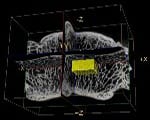The search for mysterious dark matter at an abandoned mine in Minnesota is the subject of “Mining for Missing Matter” in the Aug. 28 issue of Science News.
Journalist Ron Cowen interviewed SMU scientist Jodi Cooley, an assistant professor of experimental particle physics in the SMU Physics Department.
Cooley is a member of a scientific collaboration investigating dark matter, the Cryogenic Dark Matter Search experiment. It is located deep in the Soudan Underground Laboratory.
Cooley and her collaborators reported in the journal Science that they couldn’t rule out that they may have seen a glimpse of dark matter.
Physicists have been searching for dark matter — the substance that makes up most of the matter in the universe — for decades.
Cowan writes: ” ‘My hope is that the next generation of experiments will discover dark matter” within the next few years,’ says CDMS II researcher Jodi Cooley of Southern Methodist University in Dallas. After making their initial discovery, researchers could then tailor experiments to unveil dark matter’s detailed nature, she says.”
EXCERPT:
“The workers have journeyed deep into the Earth to plumb the darkest depths of the cosmos, hunting for the missing material believed to account for 83 percent of the universe’s mass.
That material, known as dark matter, must exist, astronomers say, because the cosmic allotment of ordinary, visible matter doesn’t provide enough gravitational glue to hold galaxies together. Although the missing material shouldn’t be any more prevalent in the underworld than above ground, dark matter hunters have good reason to frequent Soudan and other subterranean lairs. Because dark matter particles would interact so weakly, experiments designed to detect the dark stuff could easily be overwhelmed by the cacophony of other particles. So scientists at Soudan and elsewhere use Earth’s crust to filter out cosmic rays — charged particles from space that bombard Earth’s atmosphere.
Physicists have been directly searching for dark matter for more than two decades. But until recently, only one experiment, beneath a mountain in central Italy, had consistently reported evidence of the invisible particles. Now two more experiments have found similar hints. When taken together, the findings suggest that the most popular models for dark matter may not be correct — the particles pegged have a lower mass than many physicists had proposed.
 The search for mysterious dark matter at the Soudan mine in Minnesota is the subject of “
The search for mysterious dark matter at the Soudan mine in Minnesota is the subject of “
